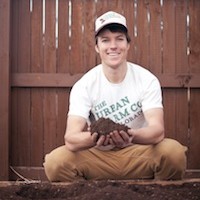Elephant Journal loves Bryant and the Urban Farm Co. mission. They use beetle kill whenever they can get it for their boxes. We don’t like plastic tarping for gardening. Plastic is bad. So bad! Just awful! We hate plastic. Anyways! This helpful lesson and others can be found here. ~ ed.
What Is Compost?
Compost is like high-octane jet fuel for the organic gardener.
Compost is the decomposition of organic matter (more specifically, nitrogen and carbon-based matter). It creates a nutrient-rich substance called humus, which can be added to your garden.
Compost releases nutrients when the microorganisms in your soil break down the organic matter. It also aerates soil, retains water, and facilitates microbial life, among a dozen other things.
The best compost you can use in your garden is the compost made in your backyard. Because it’s created with such a diverse source of materials—from food scraps to grass clippings—the final product has all of the macronutrients and micronutrients your plants need to grow.
If used fresh, the beneficial microbes are immediately incorporated into your garden soil to continue working their magic in your garden.
If done right, compost doesn’t smell bad, look bad, or take a lot of work.
3 Benefits of Adding Compost to Your Garden
1. Compost replenishes nutrients to your soil, much like a fertilizer or manure would. Compost is an alternative to chemical fertilizers.
2. Soil with compost retains more moisture and loosens the soil.
3. The microorganisms from compost help aerate the soil, break up organic material, and ward off plant disease.
The Key To Compost: Carbon:Nitrogen Ratio
Everything that you put in your compost pile will either contain mostly carbon or mostly nitrogen. Carbon-based materials give your soil a fluffy body, while nitrogen-based materials make enzymes.
Carbon-based materials are brown. Nitrogen-based materials are green.
To get the right carbon:nitrogen ratio, you want 2/3 of the materials to be brown, and 1/3 of the materials to be green. This is just approximate—don’t stress too much about getting the right proportion.
Examples of carbon-based (“brown”) materials:
Branches
Brown leaves
Wood
Bark
Sawdust
Corn Stalks
Coffee Filters, shredded paper, and cardboard
Straw
Eggshells
Examples of nitrogen-based (“green”) materials:
Food scraps (includes eggshells, but not meat or dairy)
Grass clippings (make sure they’re organic!)
Green Leaves
Manure
Blood meal or other nitrogen heavy organic fertilizers
Tip: If your compost emits a foul odor, add more carbon-based materials. Your compost should release a fresh, earthy smell when the ratio is correct.
How to Compost: Creating the Compost Pile
1. Collect enough materials to build your compost pile at least 3’x3’x3’. An overly small pile is one of the biggest mistakes people make when starting. Your compost needs enough mass to heat up and decompose.
2. If you can, start the pile on bare earth. Allowing worms, bugs, and microbes to access the pile from the ground helps the decomposition process.
3. Lay 2” of “brown” material first. We recommend straw or twigs. This allows for drainage and aeration.
4. Layer “brown” and “green” materials until the pile is 3-4 feet tall. Water each layer.
5. Add a few layers of soil to incorporate microorganisms that will speed up the decomposition process.
6. Cover your compost pile with anything you can find (wood, plastic, carpet). The cover retains heat and moisture in your compost pile.
How to Maintain Your Compost Pile
1. Occasionally water your compost pile to keep it moist. The materials should be continually moist like a wrung-out sponge.
2. Turn your compost every few weeks to aerate your pile. Turning the pile more frequently will increase the speed of composting.
3. Check for heat! This is the best indication that it’s working. Your compost’s temperature should be between 130-150 degrees. If you reach your hand into the pile, it should feel warm.
4. Keep adding materials to your compost while maintaining the correct carbon-nitrogen ratio.
5. Cover any exposed fruit or vegetable product with grass clippings or “brown” material to reduce attraction of fruit flies and pests.
6. Your compost is done when the materials turn into a dark, crumbly soil. There should be very few pieces of original organic matter. It should smell earthy.
Relephant Read:
Heirlooms & Hybrids & Zebras, Oh My! 9 Tips for Growing Tomatoes.
Author: Bryant Mason
Editor: Emily Bartran
Photo: Scot Nelson/Flickr







Read 0 comments and reply